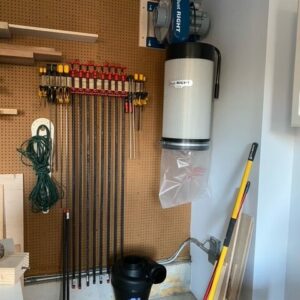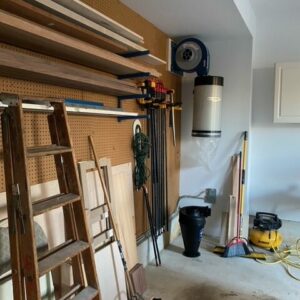I’m setting up my first official dust collector and planning out my layout for the piping. Dust collector is the Dust Right 1250 from Rockler. It’s going to be a 2 stage system and I ordered a yellow Eagle waste drum from Amazon and was planning on hanging the cyclone on the wall just below the dust collector and have flex hose go from that to the drum.
I would like some input on what kind of ductwork I should get. I’m only going to have one main run to my Dewalt table saw and have one branch off that with flex hose that I can switch to other machines (the farther away picture is about where my table saw will be and the ductwork will run along the pegboard wall. The clamps will be moved and that’s where the cyclone will go).
I was thinking about white PVC that I can just get from Home Depot instead of the metal ductwork but I heard there can be static build up with PVC and the metal ductwork will have to be grounded.
Any tips on the ductwork I should use and or runs I should do would be greatly appreciated!
Discussion Forum
Get It All!
UNLIMITED Membership is like taking a master class in woodworking for less than $10 a month.
Start Your Free TrialCategories
Discussion Forum
Digital Plans Library
Member exclusive! – Plans for everyone – from beginners to experts – right at your fingertips.
Highlights
-
Shape Your Skills
when you sign up for our emails
This site is protected by reCAPTCHA and the Google Privacy Policy and Terms of Service apply. -
 Shop Talk Live Podcast
Shop Talk Live Podcast -
 Our favorite articles and videos
Our favorite articles and videos -
E-Learning Courses from Fine Woodworking
-
-
 Fine Woodworking New England Event
Fine Woodworking New England Event -














Replies
My main run is 4 inches white pvc and is easy to install, low friction and does not seem to be a problem with static, the flex hose however that connects to the planer does generate lots 0f it even it it’s connected directly to the dust collector.
It's extra work, but put the system together with tape and live with it for a few months before you glue the pvc. You may find your new setup needs adjusting. I wound up adding a drop near where I do my sanding. With that small collector you should allow for caps and avoid blast gates, they always wind up leaking and you ned all the suck you can get.
I used pvc sewer pipe. It is thinner than what would typically be used for interior plumbing and cheeper but holds up fine. The sewer pipe has bell ends so you may not need as many fittings. It also mates up well with plastic dust collection fittings like blast gates without adaptors.
On vertical fittings where there is some stress on the joint I used a small sheet metal screw to hold everything together (yes it theoretically interrupts flow but I've not had material collecting when I have had to rework parts.
On all joints I just used a little silicone caulk to seal them. It gives a little ability to flex, and is easier to remove if I want to rework something than a glued fitting. Had the collector running, and smeared it into the joint with a gloved finger until I couldn't hear any air leaks.
I get a little static but mostly in the flex pipe off my planer after running a lot of material. I used to have it grounded and honestly didn't make a big difference.
That's a bit under-powered for a 2-stage but with care it can be made to work. The problem is relatively limited static pressure - with more HP you don't always get more CFM but you get higher static pressures that can really shift dust and chips, and you'll lose some of that in the separator. The difference in static pressure between a lower and higher power sucker is small in absolute terms - not in the region of a shop vac, but quite sufficient to make a massive difference. Bigger machines take up a LOT of space though so your neater solution is probably the right way to go to start with and is also very cheap. You could possibly improve it with a cannister type filter. I've only ever added one in a big upgrade so it's not a fair test, but Youtube loves cannisters.
I had a similar spec setup for years, running 4" sewer pipe. It would suck well enough to clear most of the chips from an 8" jointer but could not manage a larger machine.
A 3HP cyclone in the same system will clear all the chips and is also powerful enough to suck dust through 2" pipe for such as my blade guard, spindle sander and chop saw. The smaller machine was inadequate to this task.
As to how to set it up, the general engineering principles of short runs, smooth curves and limiting the amount of flex-hose apply but beyond that, until you get to professional setups, really it's a mug's game overthinking it.
In a small shop you usually don't have much choice about pipe routes, so put it where it is needed and keep it out of the way - if that means a few extra bends then go for it and don't let anyone tell you not to - it will like as not be fine and if not, well you learned something. If your shop is big enough for any reasonable run to be too much then you need the bigger machine already! You can run at least 20' through at least 5 bends without any issues. Can't say more than that as it's my longest run...
Keep it cheap. 4" sewer pipe with cheap glue fittings. Don't bother sealing the joints - again if you need that minuscule amount of air then you need a bigger machine. It's not going to make the slightest difference to chip collection and it allows you to change with minimal cost and waste. A small screw or two will hold together those where friction is not enough and is much easier than caulk or tape to remove later. You can get push-fit sealing fittings but they don't improve performance, cost more and are bulkier.
Yes, you can glue or tape, but seriously, to quote Newt from Aliens - it won't make any difference. I'd probably only glue pipe if it was going somewhere I would not be able to get to if it were to fall apart later.
If you are careful with how you position your pipe, you can also get away with screwing it to blocks on the wall for support. No need for fancy supports, just a no6 screw into the wall through bends and connectors. It's not got to be watertight after all so you can do things that plumbers can't.
Blast gates will be needed - unless you are totally loaded with cash, buy the cheapest nastiest black plastic ones. They are the best value by far. Trim the end opposite the gate handle off on a saw until you can just see the end of the gate and you have a perfect gate - won't last for ever, but it won't clog with dust. Yes, yes, yes - tiny bit of air leakage when the gate is open but again utterly trivial and does not affect the chip/dust performance of the system at all even with the smaller sucker. It's not even worth bothering trying to make a flap - simply not needed. I have loads of them and they have worked well for 3 years since I discovered the cutting trick. They never block and cost bugger all.
These gates may need adapting to suit 100mm sewer pipe - I do this with a short length of pipe and plumbing silicone.
With that machine going for bigger pipe will reduce performance rather than enhance it due to static pressure issues - there are engineering tables you can use to look it up but 4" is your friend here.
As for static - been in too many arguments on this forum - I ignore the issue as it's a non-issue. You cannot possibly cause an explosion in your shop - there is no way to generate either a spark or an explosive mixture in that setup and there is no meaningful way to ground plastic pipe. There has never been a documented case of static causing an explosion in a home shop, and short of deliberate efforts to make it happen, there never will be. If you have metal pipe it must be grounded, but for an entirely different reason - to stop you dying if for any reason it also gets connected to the hot side of your electrical system.
Once again, don't overthink it. Don't get hung up worrying about layout and do what works. If you get static that annoys you then deal with it. If the pipes don't work then play with the setup. Some of what I have said here will doubtless horrify many as it goes against the woodworking dogma of piping perfection, but it passes the most important test of all - it works.
This forum post is now archived. Commenting has been disabled